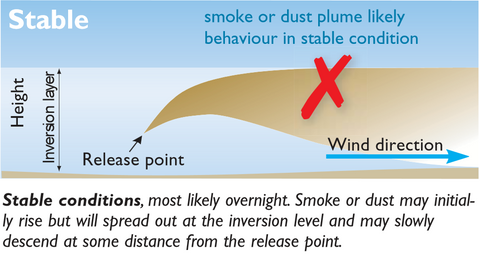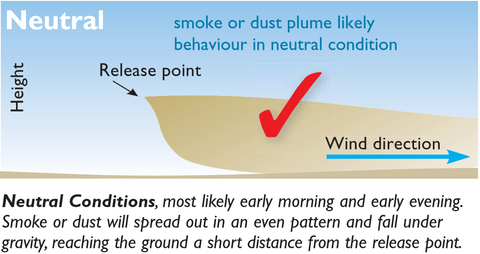Pesticide spraying and its effectiveness are extremely sensitive to atmospheric conditions, which is the reason why people in the agricultural field utilize Kestrel Agriculture Meters.
With the approval of Dicamba by the EPA in late 2016, a lot of fear from farmers on how to spray, which nozzle to use, and when to spray based on atmospheric conditions.
Spaying from the wrong time/place based on atmospheric conditions can lead to:
- Breaking the law
- Lawsuits
- Chemical droplets drifting into other fields / habitats / etc..
- Unhappy neighbors
The Agriculture Kestrel Meters can offer a solution to mitigate the fear by addressing a few issues:
- Time/Date stamp
- Wind Speed
- Wind Direction
- Delta T
May US farmers are unfamiliar with the benefits of a Delta T reading. This page serves as a good overview for understanding this principal and the power of a simple measurement can do. While mandated in Australia, the US may not be far behind as this serves to protect the farmer and neighboring lands when spraying. The best meter for his is the Kestrel 5500AG meter. Waterproof, floats, US Made, and backed by a 5 year warranty.
WEATHER GUIDELINES FOR PESTICIDE SPRAYING
• Read the product label and follow all label instructions.
• Spray when wind is steady and ideally 2-9 mph.
• Avoid variable or gusty wind conditions.
• Avoid calm conditions - small droplets may remain suspended for long periods.
• Spray when wind blows away from sensitive areas.
• Avoid spraying in temperatures above 82 °C.
• Aim to spray when Delta T is between 2 and 8 and not greater than 10.
• Do not spray when inversion conditions exist.
• Aim to spray when the atmosphere is neutrally stable.
• Most chemicals require a rain free period – check the label.
• Be aware of local topographic and convective influences on wind speed and direction.
• Record on-site weather conditions at spray time. Using the Kestrel 5500AG
Atmospheric Stability
Atmospheric stability is the measure of the atmosphere's tendency to resist or assist vertical motion of air. Stable atmospheres will keep air from moving up (thus carrying particles with it), while an unstable atmosphere will resist any vertical motion. A neutral atmosphere will do neither, and is the best for spraying because the droplets will neither get swept up by unstable air currents nor concentrated by stable atmospheres. Diagrams for each are shown below:
Thermal Drift
Thermal Drift is caused by an unstable atmosphere, and causes chemical droplets to be carried significant distances from the target area by thermal eddies. The measure of Delta T is increasingly being used by sprayers to measure spray conditions and prevent thermal drift.
Delta T
Delta T is the measure of evaporation rate and lifetime of a droplet. It is calculated by the dry bulb temperature minus the wet bulb temperature. A Delta T between 2 and 8 is ideal for spraying, and should never be higher than 10. Kestrel 5500AG meter accurately measure Delta T for farming applications instantaneously.
More specifically as stated from John Deer guidelines, Delta T is the difference between wet bulb and dry bulb temperature, it combines the effects of temperature and relative humidity on the survival of spray droplets. Delta T is an important indicator for acceptable spraying conditions such as evaporation rate and droplet lifetime. A lower Delta T results in better survival of fine droplets. Dry air with low humidity has a high Delta T above 46.4 (8) resulting in high evaporation rates and poor droplet survival. Weeds can also be stressed because of high Delta T if there is not adequate moisture. Very moist or humid air has a low Delta T, less than 35.6 (2), and consequentially droplets can survive too long if too small to fall to the ground. With a coarser spray, it is possible to start in the same range, potentially finishing with a Delta T of 18 to 21.6 (10 to 12), if the other conditions are suitable and the plants are not stressed. It is however not recommended to start spraying when the Delta T value is already 18 (10) or over. Increasing chemical efficacy as well as reducing spray drift is paramount to many customers. Delta T should be taken into consideration along with other conditions such as wind speed and direction, droplet size and boom height to ensure best practice.

Wind
Weather maps may be used to measure wind speeds over a given area, but be aware that wind at ground level can differ greatly from a weather map due to obstacles in the actual wind's path that redirect and deflect predicted wind flow. These winds can be very chaotic in speed and direction, so a live meter reading is always recommended. Also, wind can vary throughout the day, with the least wind early in the morning and the most during late morning/early afternoon. Spray when the wind is blowing away from sensitive areas. Ideal wind speed for spraying is between 3 and 15 km/h.
Temperature
Avoid spraying when temperature is above 82°F. Typical meteorological temperature readings are taken in the shade, over 1 meter above the ground. The issue with this in regards to farming is that on a hot day, ground temperature may be 68°F or even higher. These high ground temperatures can cause volatile pesticides and herbicides to evaporate quickly and create a harmful vapor, even if the air temperature appears to be suitable. A live reading of the temperature is always recommended before a spray.
Temperature Inversions are layers of air in which temperature increases with height (as opposed to the normal decrease with height). A cold drainage wind (katabatibc) can contribute to the strength of inversions (A) and add to the risk of drift.
Humidity
Humidity has a great effect on evaporation rate; humidity above 45% is ideal for spraying. However, very high humidity can suppress evaporation, leading to an extended droplet lifetime and a greater chance for drift. Low humidity can cause rapid evaporation, which will also lead to drifting. A combination of low humidity and high temperature can even cause pesticides to crystallize and activate at a later time, throwing off the uptake timing of the pesticide.
Inversions frequently form in the late evening and strengthen overnight (being strongest near sunrise) before being eroded by mid morning as the air near the ground heats up.
Inversion layers are stable (see stability section) and are characterized by calm, light or variable winds, that make it difficult to predict the movement, both vertically and horizontally of spray droplets (most drift complaints involve spraying under inversion conditions).
Within inversion layers droplets may rise and be trapped at some higher level before being carried out of the target area. On the other hand droplets may remain suspended at a lower level and drift off target in light winds.
These guidelines are only a high-level overview of the atmospheric criteria important to spraying. Having a deep understanding of humidity, Delta T, temperature, and drift in regards to your particular spraying locations can be critical in successful spray applications. The Kestrel Agriculture line was designed specifically for crop sprayers, and allows them to measure all of the aforementioned criteria and more. Keep in mind that when spraying Dicamba, on-site weather condition readings are required before each spray.
Sources
Pesticide Safety Education Program: Cornell University
"Weather for Pesticide Spraying" - Australian Government Bureau of Meteorology
"Spray Drift Management" - Primary Industries Standing Committee
"How to Prevent Spray Drift" - Queensland Government DPI publication
The University of Queensland
Nufarm
Grains Research and Development Group - GRDC







